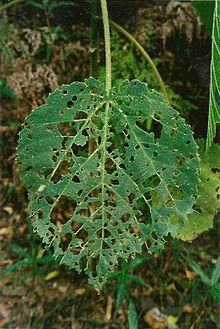
The Goliath birdeater belongs to the tarantula family Theraphosidae. Found in northern South America, it is the largest spider in the world by mass and body length, and second to the giant huntsman spider by leg span. It is also called the Goliath tarantula or Goliath bird-eating spider; the practice of calling theraphosids "bird-eating" derives from an early 18th-century copper engraving by Maria Sibylla Merian that shows one eating a hummingbird. Despite the spider's name, it rarely preys on birds.
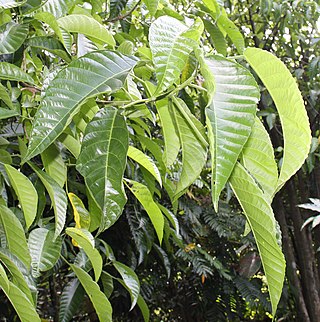
Dendrocnide is a genus of approximately 40 species of plants in the nettle family Urticaceae. They have a wide distribution across North East India, Southeast Asia, Australia and the Pacific Islands. In Australia they are commonly known as stinging trees.

Dendrocnide moroides, commonly known in Australia as the suicide plant, stinging tree, stinging bush, or gympie-gympie, is a plant in the nettle family Urticaceae found in rainforest areas of Malesia and Australia. It is notorious for its extremely painful and long-lasting sting. The common name gympie-gympie comes from the language of the Indigenous Gubbi Gubbi people of south-eastern Queensland.
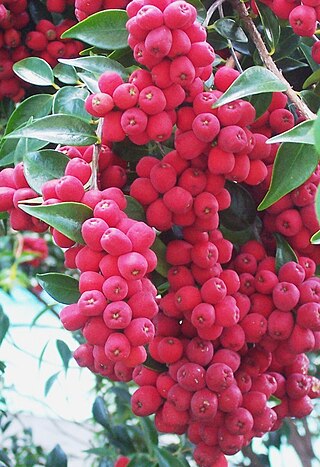
Syzygium luehmannii is a medium-sized coastal rainforest tree native to Australia. Common names include riberry, small leaved lilly pilly, cherry satinash, cherry alder, or clove lilli pilli.

The green ringtail possum is a species of ringtail possum found only in northern Australia. This makes it unique in its genus, all other members of which are found in New Guinea or nearby islands. The green ringtail possum is found in a tiny area of northeastern Queensland, between Paluma and Mount Windsor Tableland.
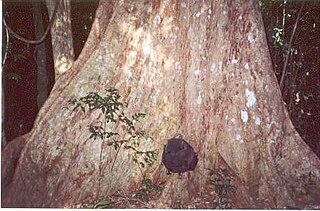
Syzygium francisii is a native Australian tree, common on the eastern sea board, between Morisset, New South Wales and Gladstone, Queensland. Common names include giant water gum, rose satinash, and Francis water gum. The habitat of Syzygium francisii is rainforest on basaltic or fertile alluvial soils.

Cryptocarya obovata is a species of laurel growing on basaltic and fertile alluvial soils in eastern Australian rainforests. It is found from Wyong in New South Wales to Gympie in the state of Queensland. Extinct in the Illawarra region, allegedly last seen in the Illawarra in 1818 by Allan Cunningham. The species was included in the Prodromus Florae Novae Hollandiae et Insulae Van Diemen, 402 (1810)

Rhodamnia rubescens, the scrub stringybark, brush turpentine, or brown malletwood, is an evergreen rainforest tree of the myrtle family Myrtaceae, that is native to Eastern Australia. Identified by a stringy type of bark and triple-veined leaves, it grows in a variety of different rainforests from the Batemans Bay region of southeastern New South Wales to Gympie in southeastern Queensland. It is not seen in the cool temperate rainforests. The pathogen myrtle rust threatens the existence of Rhodamnia rubescens.

Croton verreauxii known as the green native cascarilla is a small tree or shrub growing in dry rainforest and rainforest margins in eastern Australia.

Elattostachys nervosa, known as the green tamarind or beetroot tree is a common rainforest tree of eastern Australia. Found in all types of rainforest, growing from Paterson, New South Wales in the south to Gympie in south east Queensland. The name Elattostachys refers to "little spikes", a flower feature of other plants in this genus. Nervosa refers to the prominent leaf venation. Beetroot Tree refers to the beetroot red leaves of the new growth.
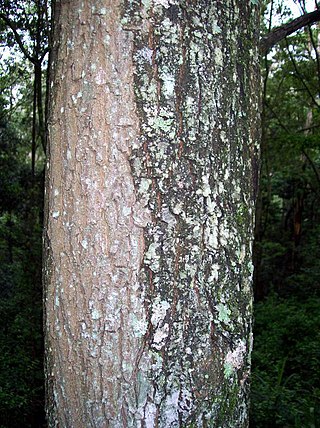
Bridelia exaltata, known as the brush ironbark or scrub ironbark, is a tree of eastern Australia. It occurs in and on the margins of the drier rainforests. Also occurring by streams, often in association with the Black Bean, up to an elevation of 600 metres above sea level. It occurs from Seal Rocks, New South Wales to Maryborough, Queensland.

Dendrocnide photiniphylla, the shining-leaved stinging tree, is a rainforest tree of eastern Australia. It occurs from near the Colo River northwest of Sydney to Cooktown in tropical Queensland. A versatile species, it occurs in many different rainforest types. The specific epithet photiniphylla translates to shining leaf. The generic name translates to stinging tree.
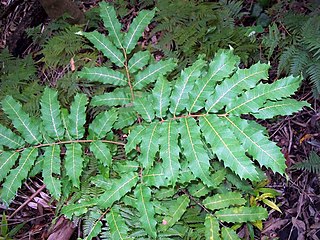
Cupaniopsis newmanii is a rainforest plant in the soapberry family. It is native to eastern Australia. The common name is long-leaved tuckeroo. A rare plant, with a ROTAP listing of 2RC-. The habitat sub tropical rainforest ranging from Mullumbimby in New South Wales to Gympie in south-eastern Queensland.
Dendrocnide peltata, commonly known simply as the stinging tree or jelaton, is a large tree in the nettle family Urticaceae. With the other species of the genus Dendrocnide, it is known for the stinging hairs which cover the whole plant and cause severe pain when touched. The Latin specific epithet peltata means "shield shaped", referring to the shape of the leaves.

Dendrocnide meyeniana or the poisonous wood nettle is a species of tree in the family Urticaceae, native to the thickets and secondary forests of Taiwan and the Philippines. The specific epithet meyeniana comes from Meiyuan/眉原, a place name in Nantou County, central Taiwan. Dendrocnide meyeniana is commonly referred to as the lipa tree, but more specifically lipang kalabaw or, more rarely, apariagua. In Philippines, the plant is named bulan-bulan in the Iloilo province, and other areas with Bisayan languages.
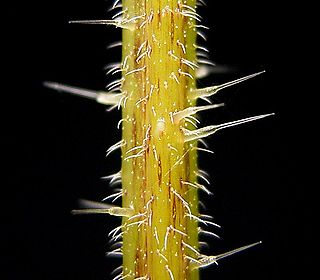
A stinging plant or a plant with stinging hairs is a plant with hairs (trichomes) on its leaves or stems that are capable of injecting substances that cause pain or irritation.

Syzygium alliiligneum, commonly known as onionwood, Mission Beach satinash or bark in the wood is a species of plant in the family Myrtaceae. It is endemic to a small part of north eastern Queensland.

Palaquium galactoxylum, commonly known as Cairns pencil cedar, Daintree maple or red silkwood, is a species of very large tree in the family Sapotaceae which is endemic to rainforests of New Guinea and northern Australia. It can produce spectacularly large buttress roots.

Doratifera vulnerans, commonly known as the mottled cup moth, Australian cup moth or Chinese Junk, is a species of cup moth of the family Limacodidae. The species was first described by John Lewin in 1805 and is the type species of the genus Doratifera. It is found in Australia. It is known for its caterpillar having unique stinging spines or hairs that contain toxins, for which the scientific name is given that means "bearer of gifts of wounds". Chemical and genetic analysis in 2021 show that its caterpillar contains 151 toxins, some of which have medicinal properties.

Dendrocnide cordifolia, commonly known as the stinging tree, is a plant in the nettle family Urticaceae endemic to the Atherton Tablelands, south west of Cairns, Queensland. Contact with the plant results in a painful sting, however the intensity and duration of the pain from this plant is extreme.
